[ad_1]
Years ago, in 2014, we set out to answer some basic questions about blogging, so we set up a survey. That project grew into a long-term gathering of blogging statistics, tracking the ever-changing trends of content marketing.
Welcome to the 9th annual blogging survey.
Each year, we ask 1000+ bloggers 20 questions about their process and their content. Then we analyze, make a bunch of charts and add input from a dozen content marketing experts.
This year we had 1016 survey responses. What follows are 26 charts based on those responses, input from the top industry experts and a set of blogging statistics that reveal some fascinating insights into an industry in flux, now more than ever.
We’ll start with the general success rate of bloggers.
Blogging is effective, but it isn’t getting easier
We’ll start with the general effectiveness of blogging. Because bloggers have a wide range of goals, we don’t define success, but rather simply let respondents report on their results at a high level.
Here is the answer to the big question, does blogging work in 2022? Yes. 80% of surveyed bloggers report that their blog delivers “some results” or “strong results.” The effectiveness of content marketing has remained steady since 2016.
But content marketing remains challenging. Most bloggers struggle to find time to create and promote their content. For many of us, blogging is not our only (or even primary) responsibility. Finding time to write and promote blog content competes with our other priorities.
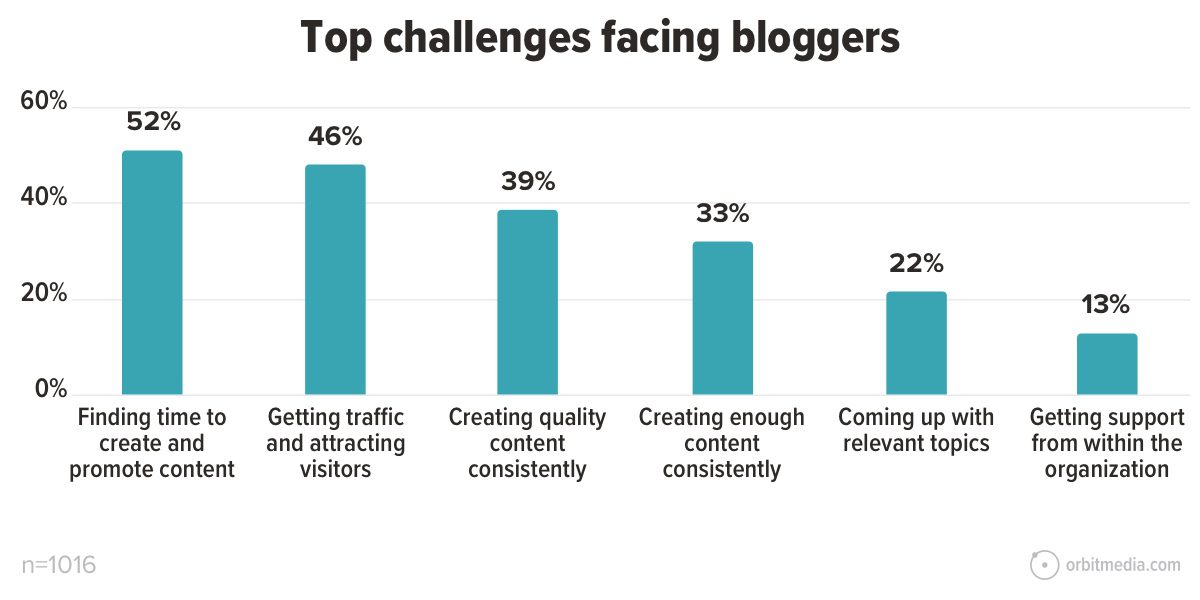
In the last section of this report, we’ll look at differences in the challenges faced by B2B and B2C bloggers.
The time that bloggers invest in their content has increased dramatically over the years, bringing us to the question, how long does it take to write a blog post? In 2022, bloggers spend an average of 4 hours 10 minutes writing an article. That’s 74% more time than in 2014 when we first conducted this research.
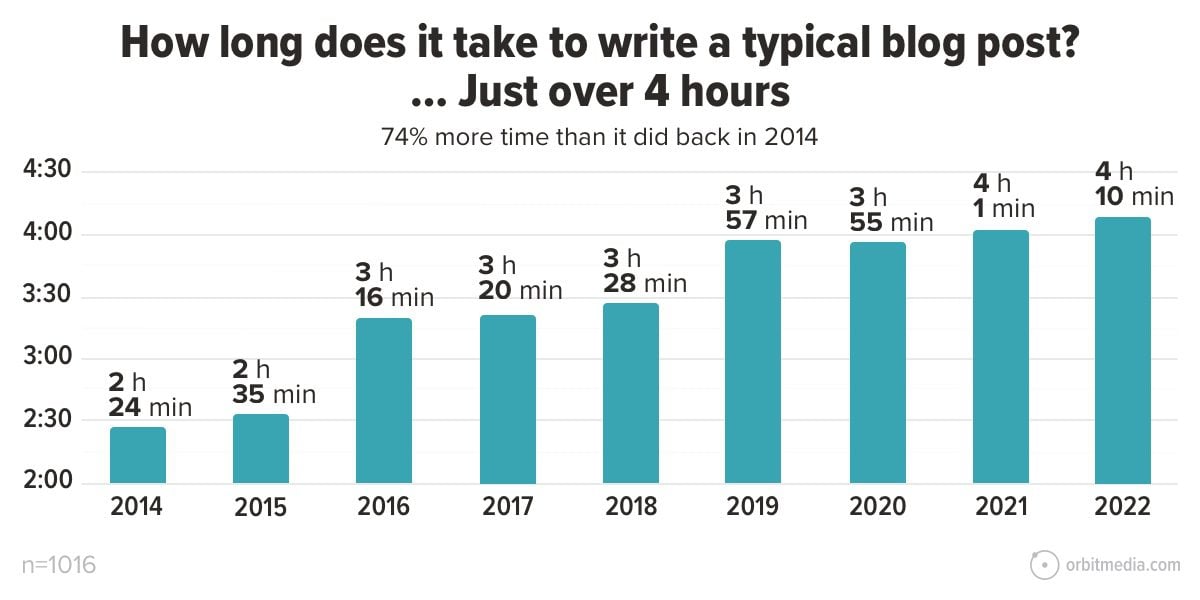
 |
Mark Schaefer, Author, Marketing Rebellion“One takeaway is that blogging is harder than it used to be. The survey results show that it takes more time and effort to cut through the noise and find results. But isn’t that true of ALL marketing? I’ve argued that this is the most difficult time to be in marketing, period. The good news is that great blogging still earns meaningful attention because it’s elite. If you blog, you’re accomplishing something 99.9% of the people in the world will never achieve. So be patient, hone your craft, and don’t give up.” |
For years, as we watched the rising time to write blog posts, we also watched the rising word count and blog post length. But the growing size of blog posts has finally leveled off. How long is the typical blog post in 2022? The average blog post length is 1376 words.
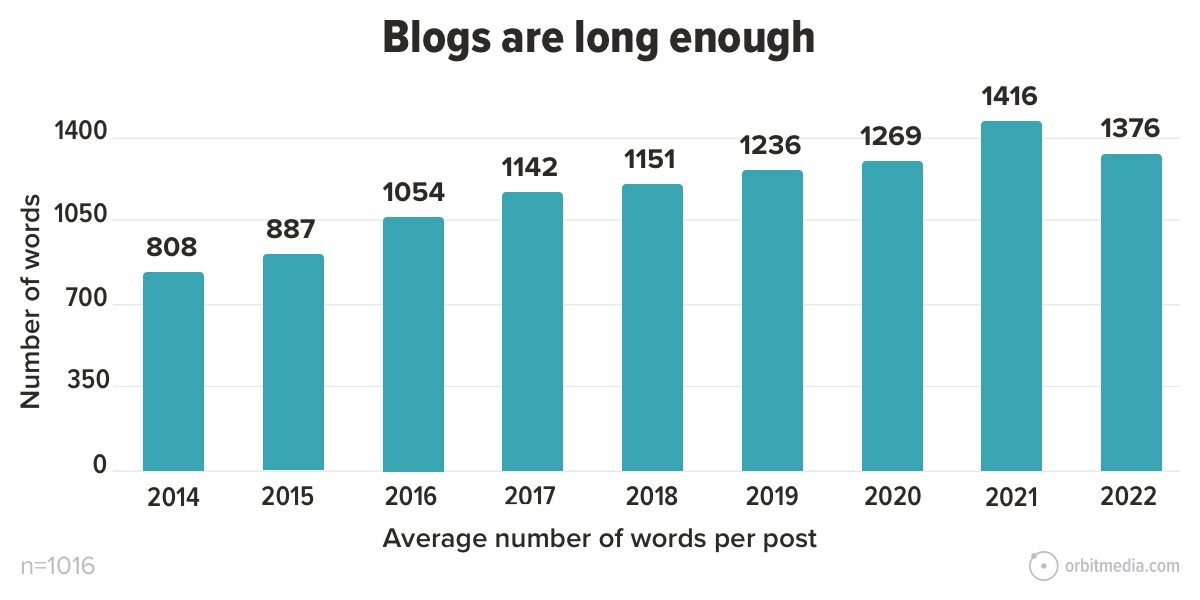
On average, blog posts are 70% longer than they were in 2014. But they are a bit shorter than last year, as if content marketers have finally decided that blogs are long enough.
But some bloggers write longer than others. While most bloggers produce articles in the 500 – 2000 word range, a small minority of just 4% of bloggers write long-form posts of 3000 words or more. These tend to be B2B bloggers. More on the B2B and B2C differences in the final section below.
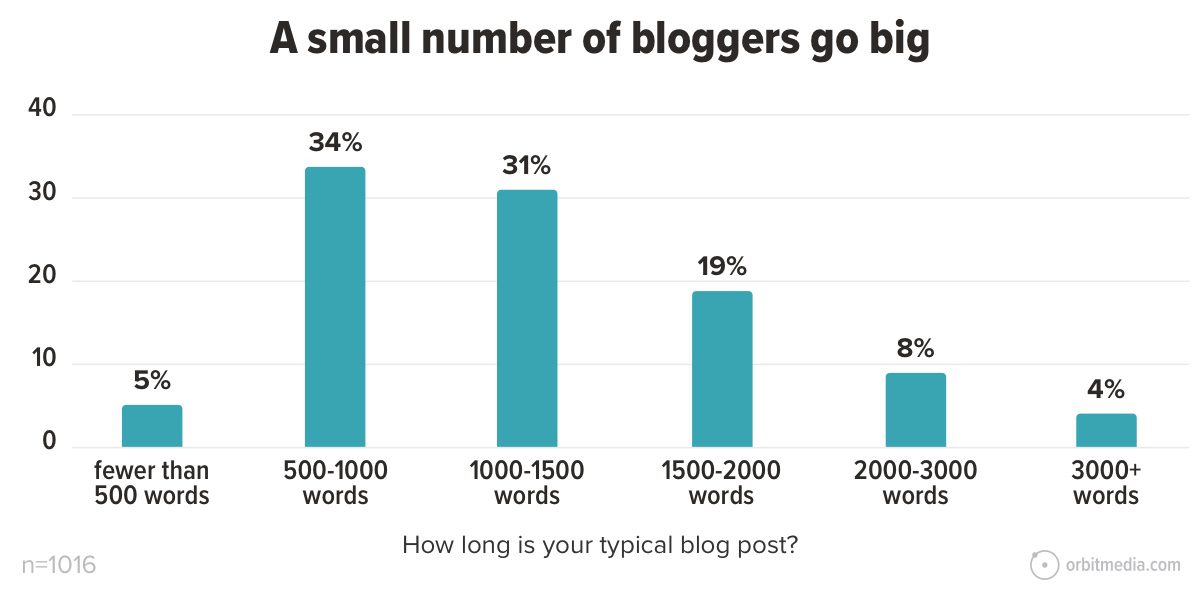
So it’s easy to understand why most bloggers say that finding time is their greatest challenge. Here we see the ever-growing efforts required to maintain a successful blog. Bloggers are spending more time writing longer posts than in years past. How do bloggers find this additional time? A content strategy has to adapt. Something has to give.
For many bloggers, the answer is to blog less often.
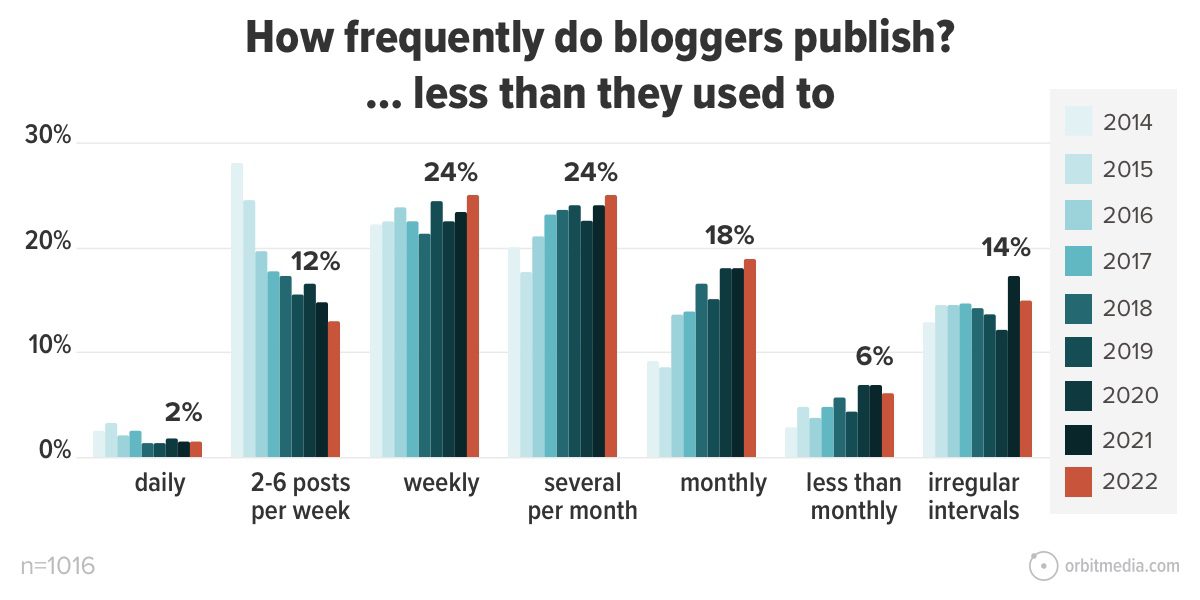
More time spent writing longer articles less often. That is the context and the current situation for bloggers.
As time-per-post goes up, posts-per-month goes down. Bloggers are making a quality-over-quantity decision. It makes perfect sense. But is this the best approach? What does the data say? Which content strategies and activities correlate with results?
Let’s take a close look at the blogging statistics and see what’s working now…
Blogging strategies that are working in 2022
In this section we’ll look at how certain strategic approaches correlate with results. Each of the items here are aspects of content strategy, including content formats and promotion channels.
We’ll group these into six general content marketing strategies. These are all examples of successful approaches.
1. Gated guides & long form lead magnets
We’ll start with a look at content formats. The data reveals which are the most common formats and also which formats correlate with and self-reported success.
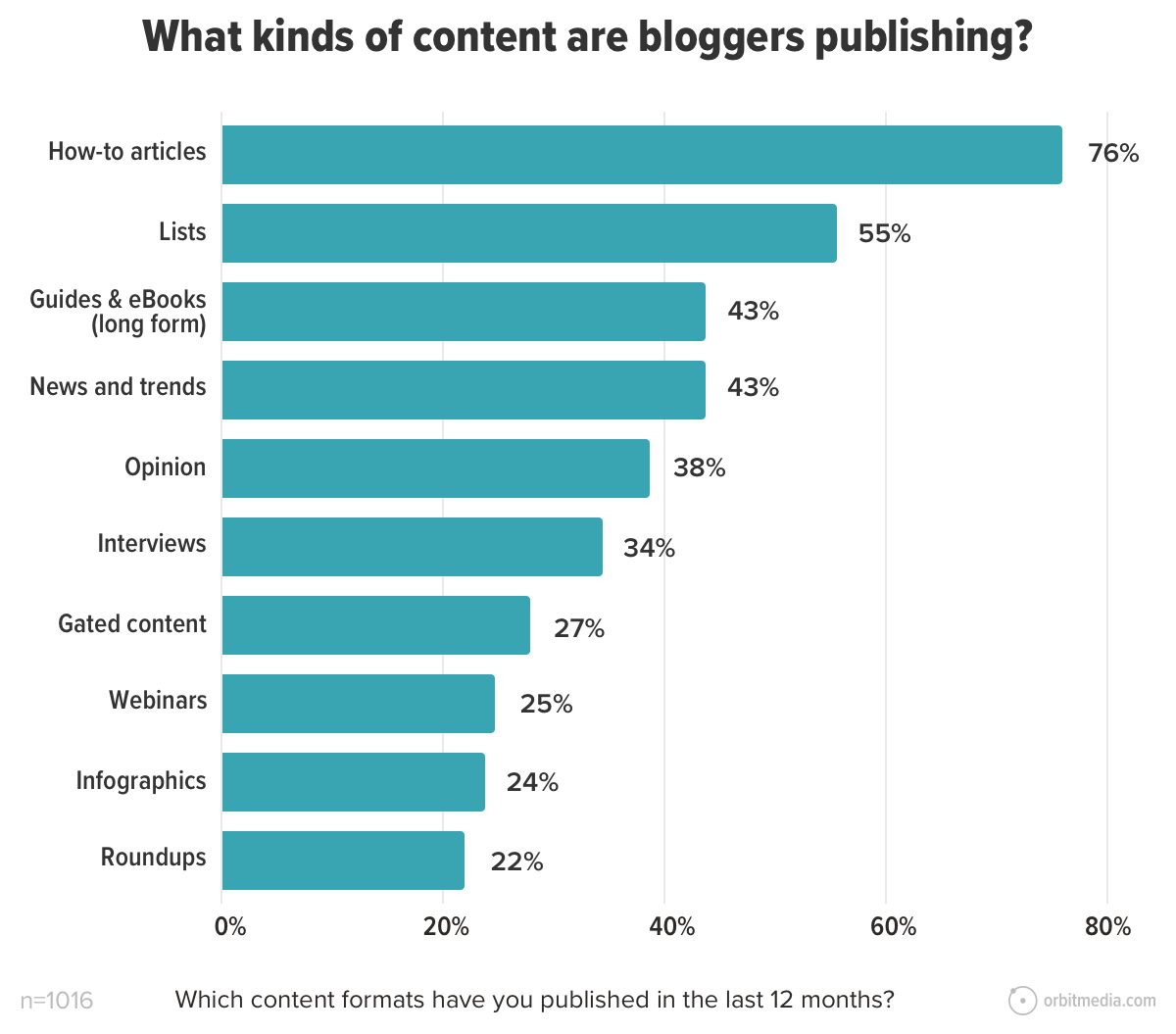
Not surprising, how-to articles are by far the most popular (76%). Most blog posts and content strategies are focused on practical utility and blog posts are intended to be useful resources to their readers.
 |
Amanda Milligan, Head of Marketing, Stacker“The results here don’t surprise me at all. I’ve seen similar trends in the newsworthy articles we create and distribute through our newswire. Data-backed lists continually perform very well, and we’re also seeing a rise in the popularity of “service journalism,” or content that helps people do something (aka, how-to content!). I just checked our top 10 best performing stories of all time, and half of them are examples of service journalism. This survey results and our own insights say to me that audiences are really favoring stories that are both easily digestible and highly useful.” |
Guides and ebooks are also a common format for content (43%) and around one in four bloggers use gates, requiring blog readers to enter an email address to get access to the second piece of content, usually that guide or ebook, often called a “lead magnet.”
But which content formats are the most effective? Of all the formats included as possible responses, guides/ebooks and gated content are the top answers among bloggers who report “strong results.”
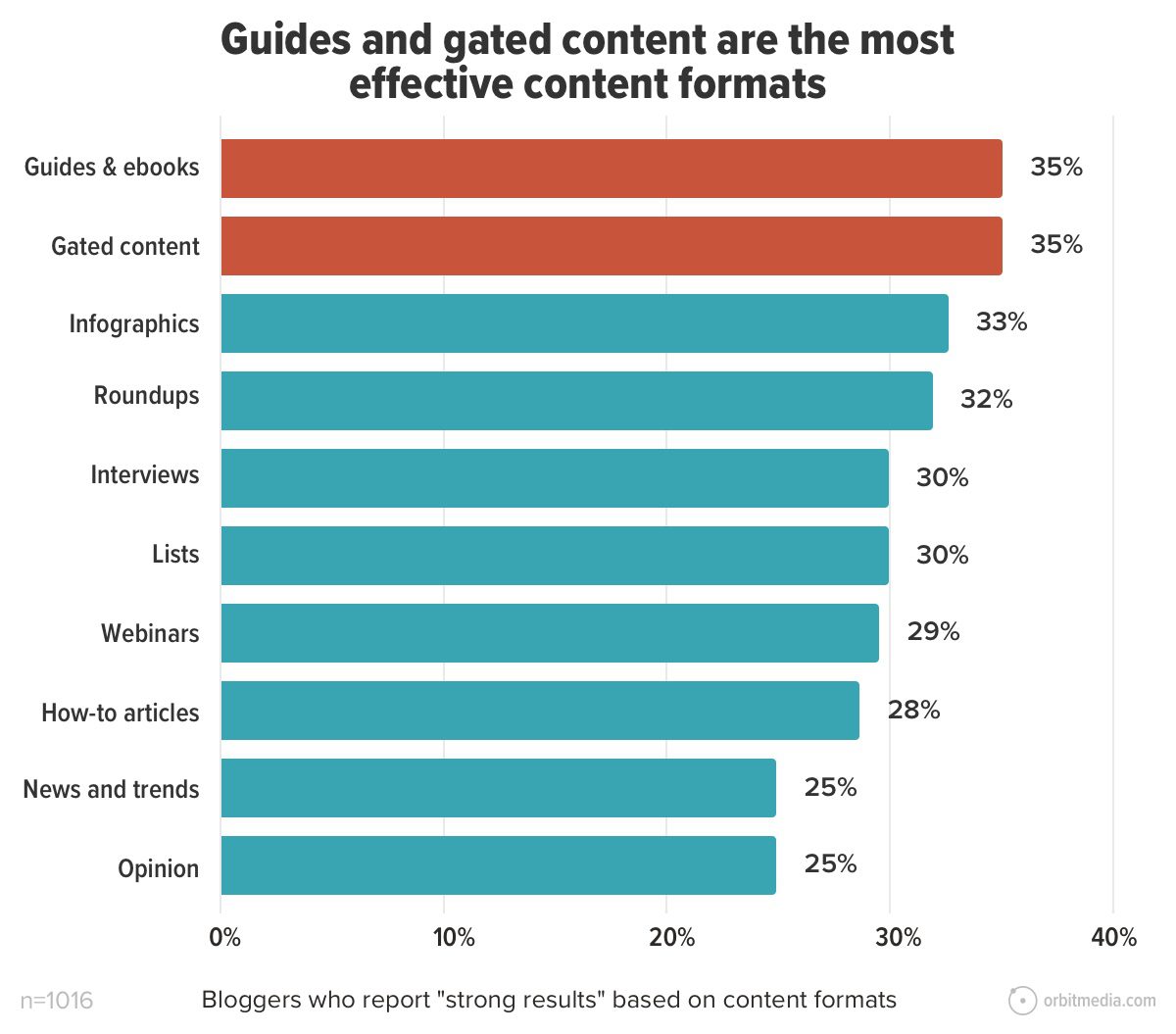
This is clearly an effective strategy. Gated content is the key feature of marketing automation and PPC landing pages. These are systems that measure results so it’s not surprising to see these at the top of this list. This data also aligns with the trend toward long form content. Guides are usually long.
Obviously, gated content isn’t the only approach. We’ve never gated anything here at Orbit and we’re pleased you can read this report without sharing your email address. But we should all at least consider using gates and guides.
 |
Carmen Hill, Content Strategist and Writer, Chill Content“It’s not surprising (I hope!) that the top types of content that bloggers are publishing align pretty closely with the types that are most effective. But I hope people don’t look at this list and assume that what is most effective for someone else will work best for them. Different businesses have different stories to tell—and different stories can best be told in different formats. Not every brand needs to double down on video or webinars or infographics. Think about what will work best for your content.” |
2. Consistent collabs with influencers & experts
This strategy centers on content that has multiple points of view. We see it’s effectiveness in the same data above. When we look at the formats that correlate with success, not far behind guides and gated content are interviews and roundups.
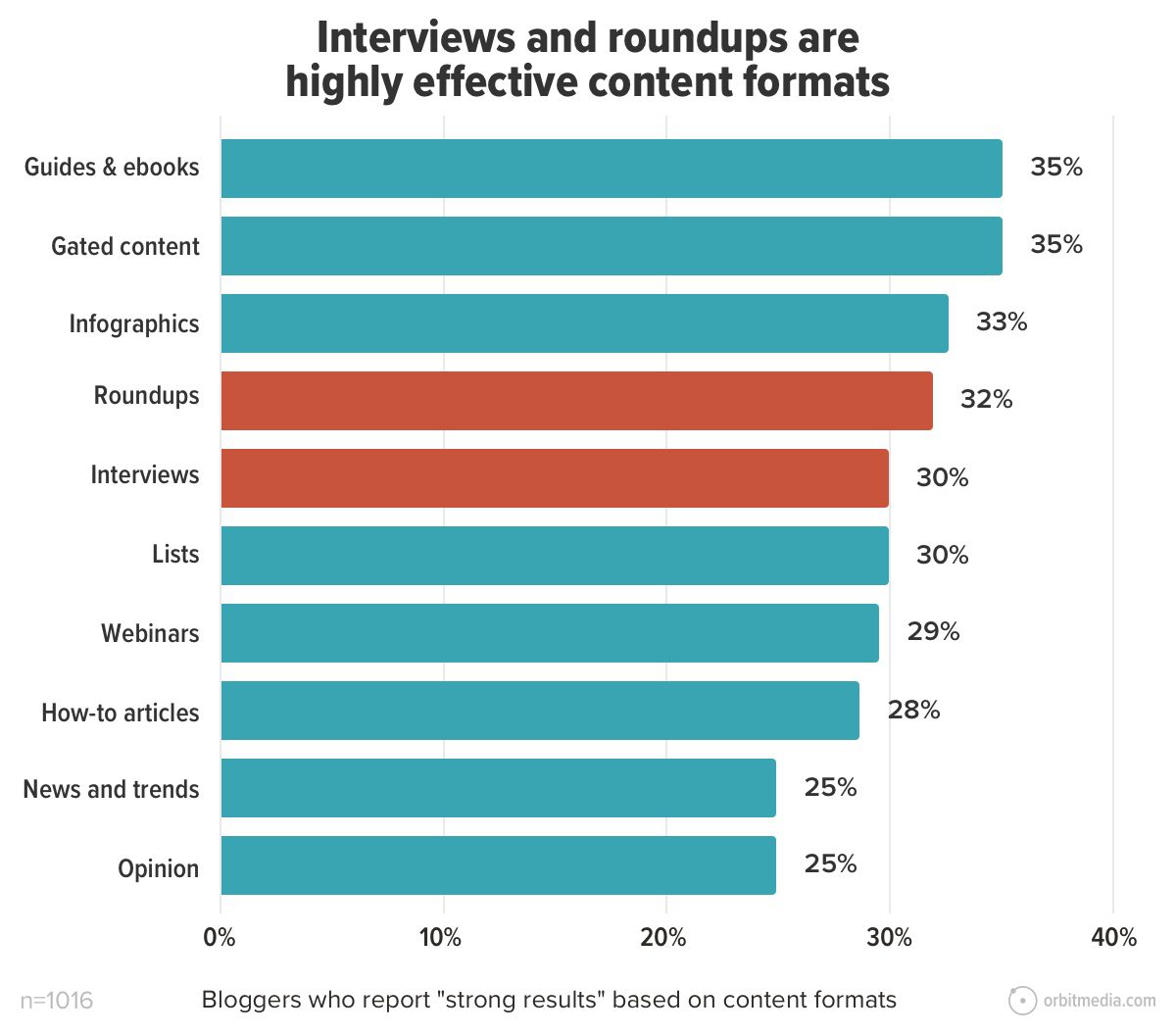
These collaborative formats for content involve working with influencers and subject matter experts. They require networking and outreach. They lead to content with multiple points of view. Collaboration makes for compelling content. No surprise, it’s effective.
The more often bloggers collaborate with influencers, the more likely they are to report success. The correlation is strong. Bloggers who “usually” or “always” collaborate with influencers are 70% more likely to report strong results.
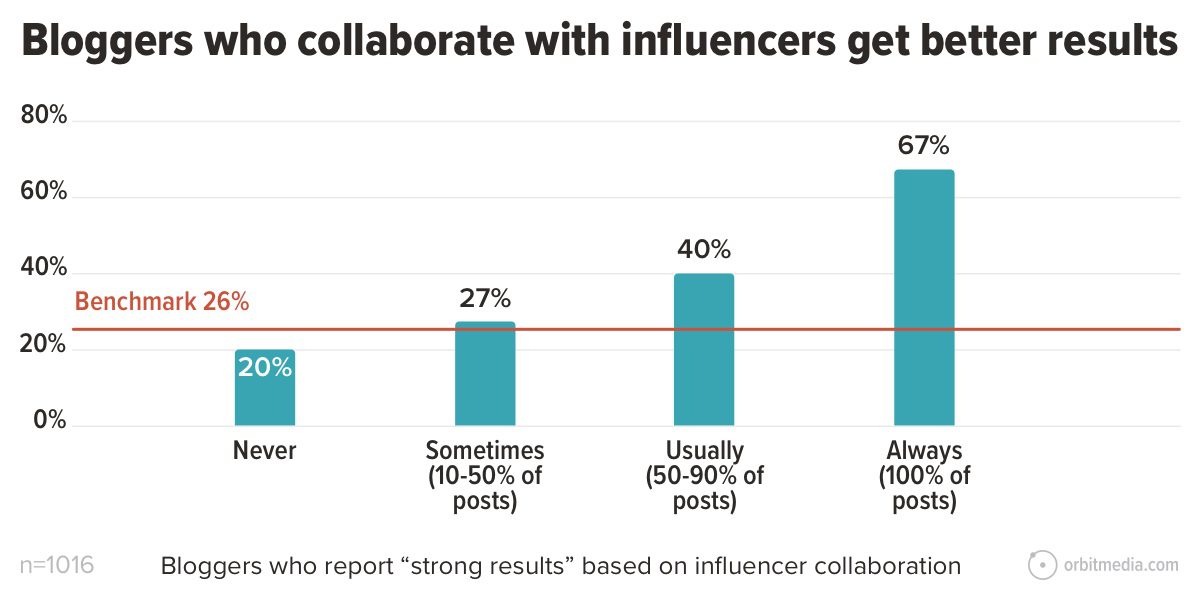
How does a content program “always” collaborate with influencers? This blog is an example. Every article on this website is either a guest post or an article by us that includes at least one contributor quote from an expert. Journalists don’t write articles without sources; why do bloggers write articles without contributor quotes?
Quotes are great for content, but the data specifically suggests including roundups and interviews in the content mix.
 |
Atiba de Souza, CEO, Client Attraction Pros“Influencer outreach and content collaboration drives HOT traffic for us. Over the last 18 months we have turned our marketing efforts entirely to creating collaborative content with SMEs and influencers. We realized that they knew our ideal clients and a referral/recommendation from them cut our sales cycle by more than 50%. In fact, 100% of our business now comes from this collaborative form of direct lead generation. But the key to co-created content is to find a way to add true and sincere value to the Influencer before they add value to you.” |
Beyond content quality, working with influencers is often good for traffic as well, as the collaborators are motivated to share on social media. These social shares may attract real visibility.
For the last five years, we’ve added influencer outreach as a possible response to the question “how do bloggers drive traffic?” It is the least common approach to driving traffic, but it is the most effective.
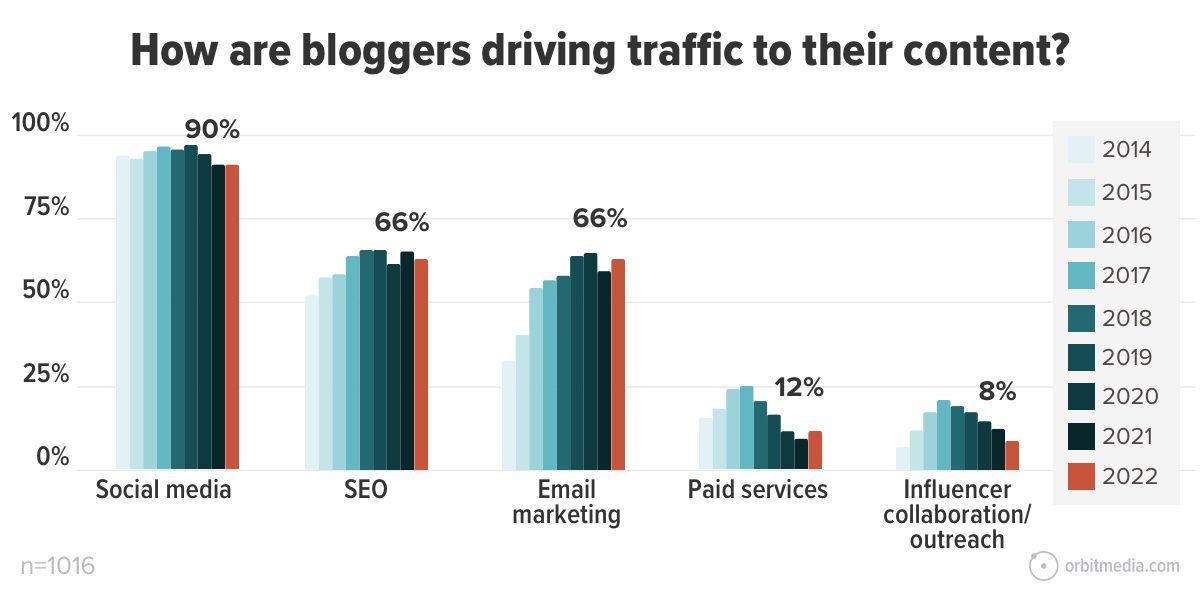
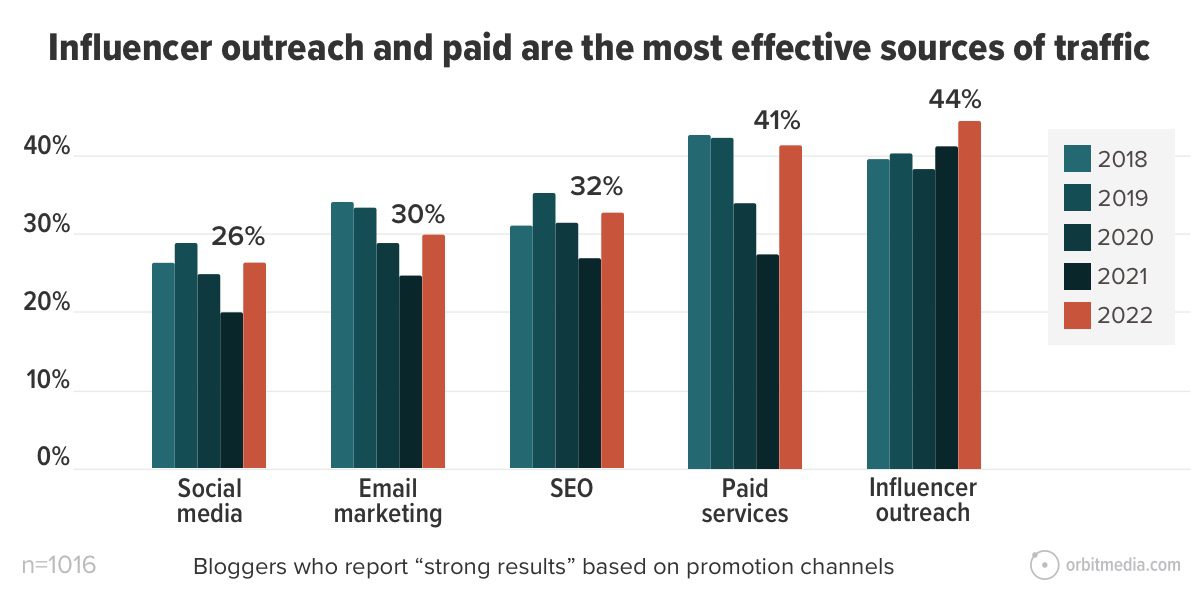
Ironically, the two most effective traffic strategies, influencer outreach and paid ads, are the least popular. For years, they were on the rise. Then in 2017, they started becoming less popular. The most effective content promotion strategies are still in decline.
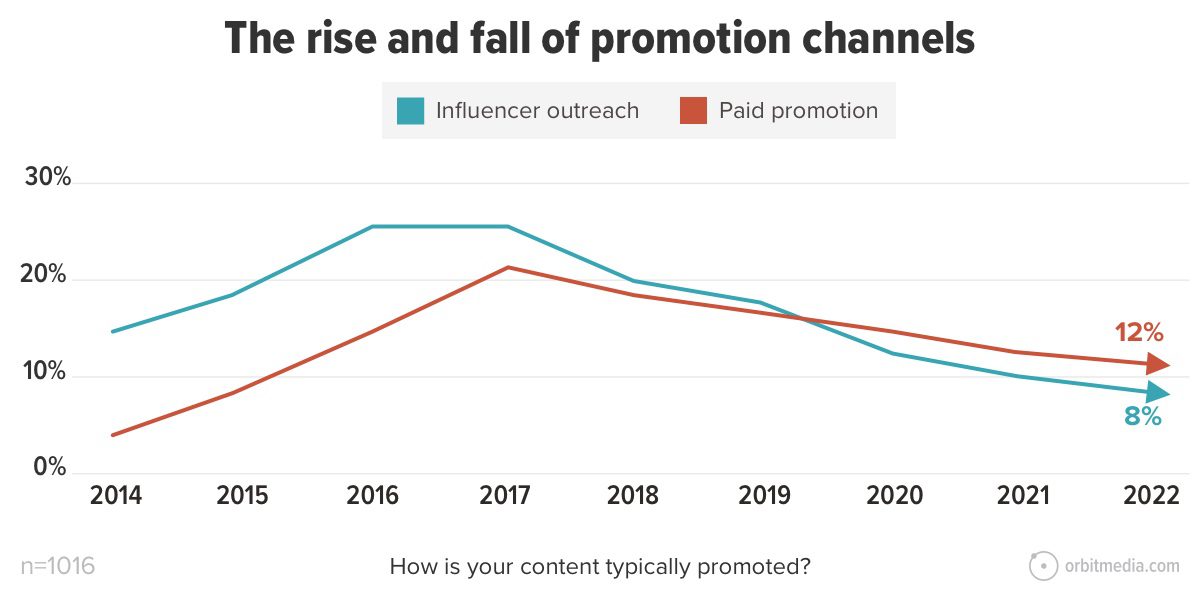
3. Evergreen, optimized & up-to-date
This strategy centers on SEO and ongoing updates of content. It’s evident in several data points in the survey. First, when we ask bloggers which sources of traffic are important to success, the top answer is organic search, year after year. Search engines are a powerful source of blog traffic, no question.
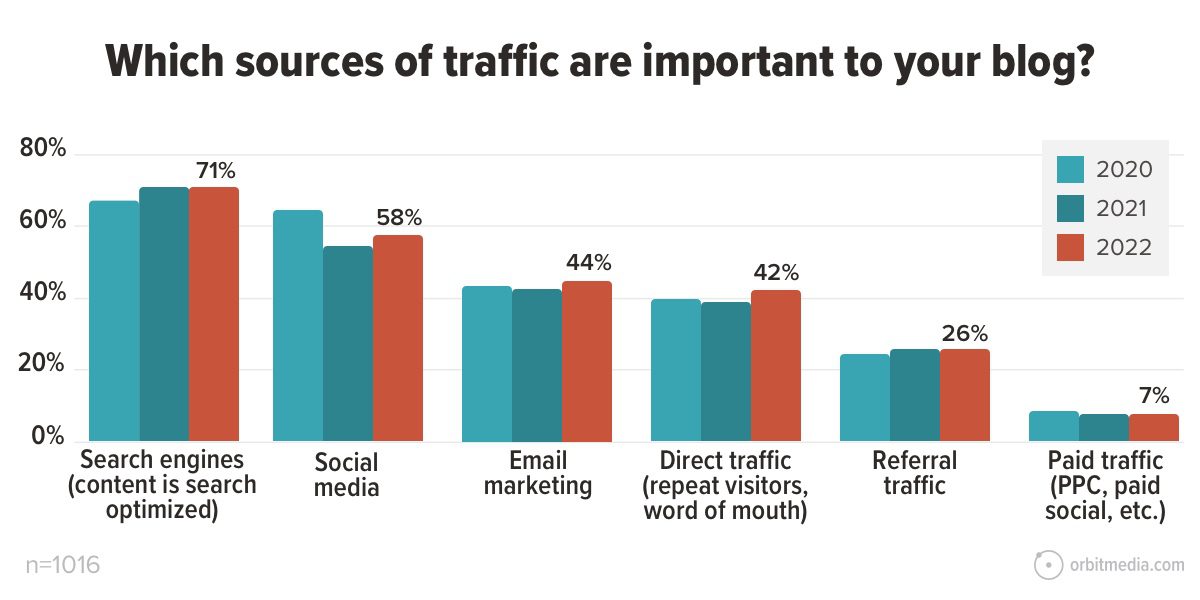
This does not mean that all bloggers are focused on search. 17% of bloggers never research keywords and only half of all bloggers research keywords for most of their content. Maybe these bloggers aren’t comfortable with SEO or don’t yet know how to research keywords.
But there is a strong correlation between more keyword research and better results. Bloggers who are the most focused on search (researching keyphrases for every article) are the most likely to report success.
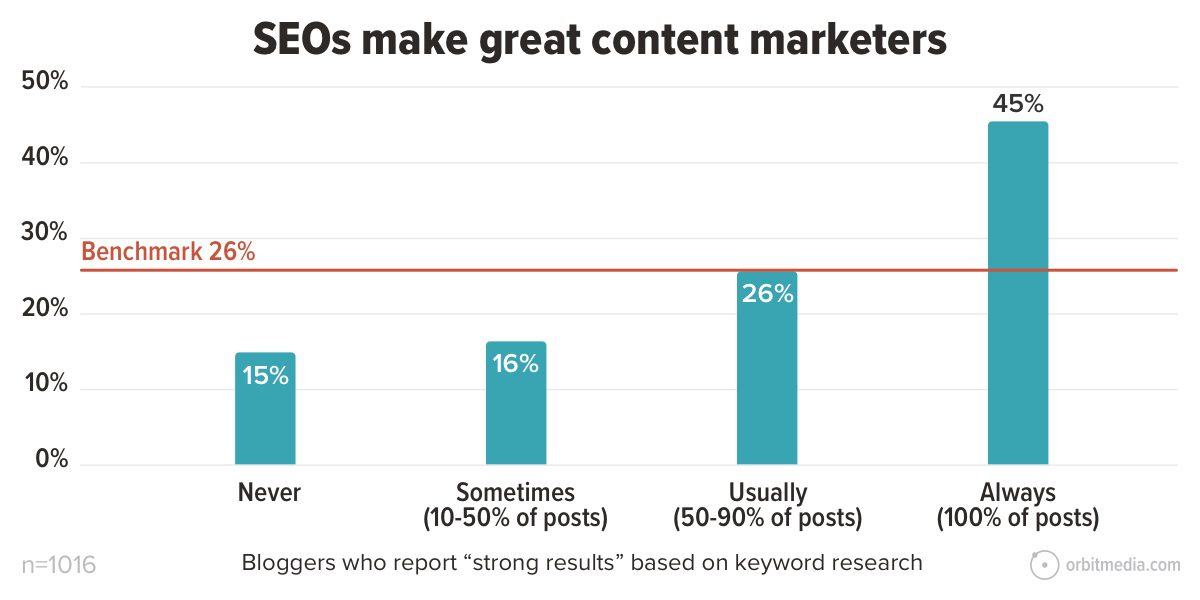
Search optimized content tends to be evergreen, as in, the content stays relevant over long periods of time. Evergreen content often has keyword opportunities, unlike news, which is ephemeral and becomes dated quickly.
 |
Zontee Hou, Head of Strategy, Convince and Convert“Often, the content that drives traffic to your website is evergreen or has been up a longer amount of time, leading to more backlinks and credibility within search engines. The problem is that that information may be out of date. Therefore, we often recommend to both our B2B clients and B2C clients to do an annual review of their top-performing content and make minor updates to bring them in line with the latest information or the clients’ latest thinking. We even do this on our own blog. Like many websites, we experience a Pareto-like split where around 20% of our content is driving 80% of our traffic. Therefore, we consistently update those top blog posts to include updated data, new examples, and even links to new content to refresh those pieces and keep them relevant. It’s a small investment project that pays out big dividends for brands that rely on search traffic and thought leadership.” |
Content marketers who publish search optimized content are actually building libraries. Content marketers who cover the news are running publications. These are the two types of content strategies: libraries and publications.
So the keyword-focused, evergreen content marketing strategy has big organic search traffic advantages. But it also has one big implication. These articles need to be maintained, updated and sometimes, rewritten. So to capture the full potential of the approach, these bloggers need to go back and update older content.
Likely these bloggers are updating articles to improve rankings.
Those that do are more successful. Bloggers who update old posts are 2.8x more likely to report strong results. That may explain the rise in popularity of updating old content.
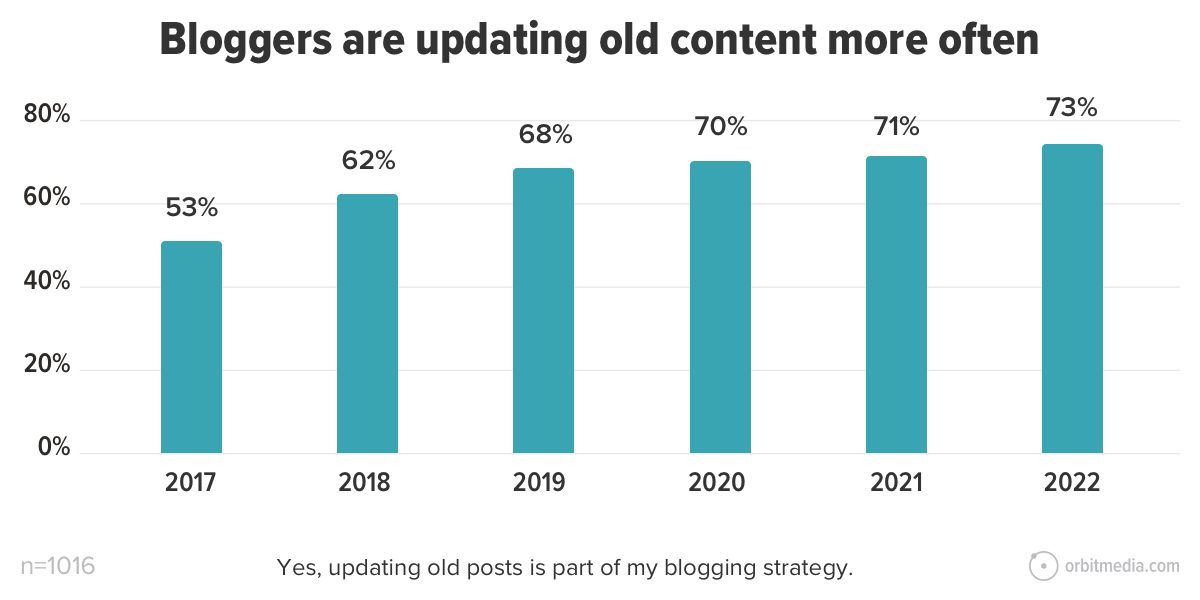
It is a strategy that combines several effective approaches: evergreen topics, optimized for search and updated over time.
4. Research reports
There are really two kinds of websites. Those that are a primary source of new information and those that are not. The decision to publish original research puts the blog in the first group. It’s a content strategy that instantly creates differentiated, authoritative content.
It’s very effective. Bloggers who conduct and publish original research are 41% more likely to report strong results. This likely explains the rising popularity of this approach since 2018, although it’s leveled off in recent years.
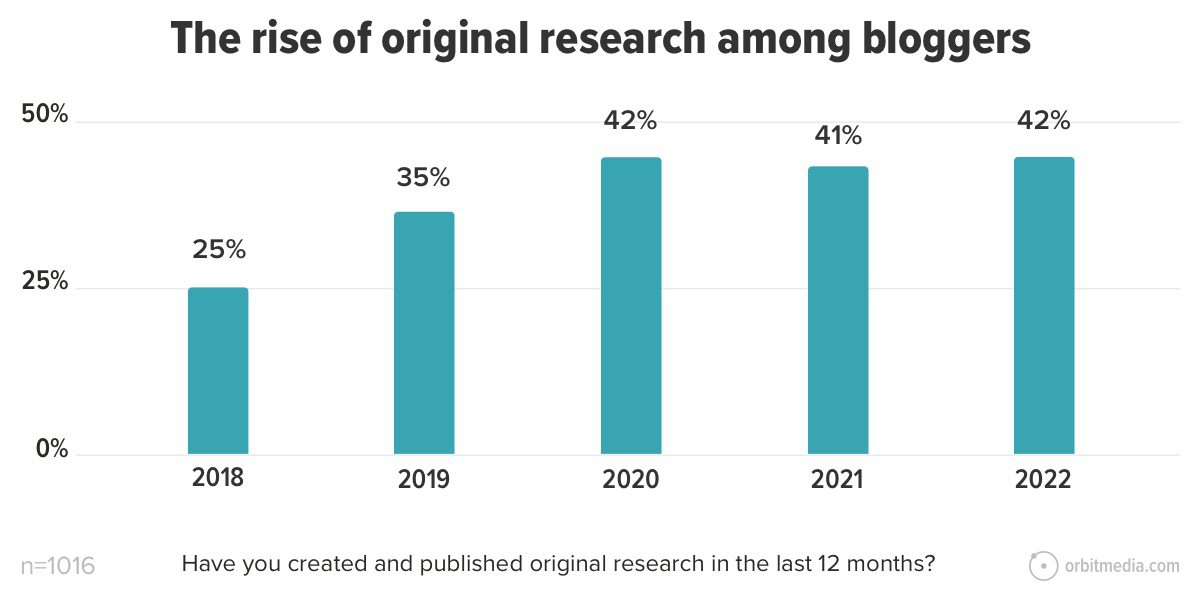
The success of this strategy is easy to understand. Not only is original research automatically differentiated, but it has some specific digital marketing advantages.
- New statistics may attract the attention of journalists and other bloggers (good for PR)
- Data and numbers make for great headlines (good for click through rates)
- Charts make for powerful, reusable visuals (good for both social media and visitor engagement)
- Data-driven articles are more likely to attract links from other websites (good for SEO)
This survey is one of many examples. The blogging statistics here have been cited by hundreds of publications around the web. Here you can see other examples of original research for marketing.
5. Super visual content
This is another way that some bloggers are differentiating their content. Like original research and long form content, it requires significant investment. Visuals are usually custom content, so adding a lot of them is not a common strategy. Most bloggers include an average of 1-3 images in a typical post. But a tiny minority are creating highly visual articles, with 10+ images per post.
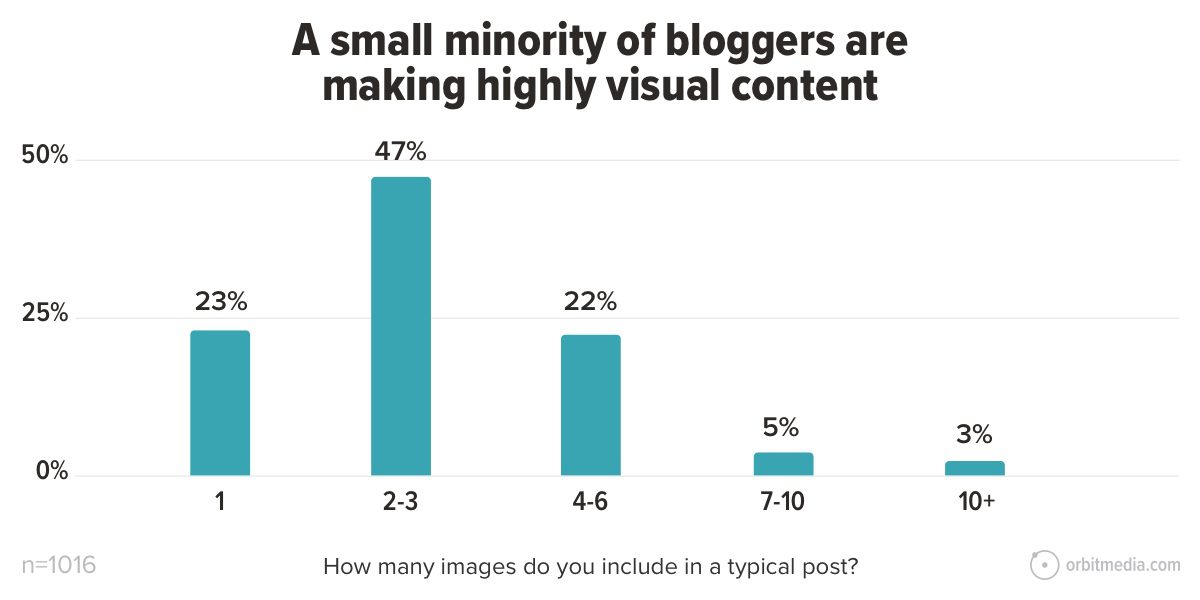
Beyond images, video is the other visual format that can set a blog apart from competitors. The use of video content among bloggers has increased over the years, but not recently. That may be because it’s often a serious time commitment.
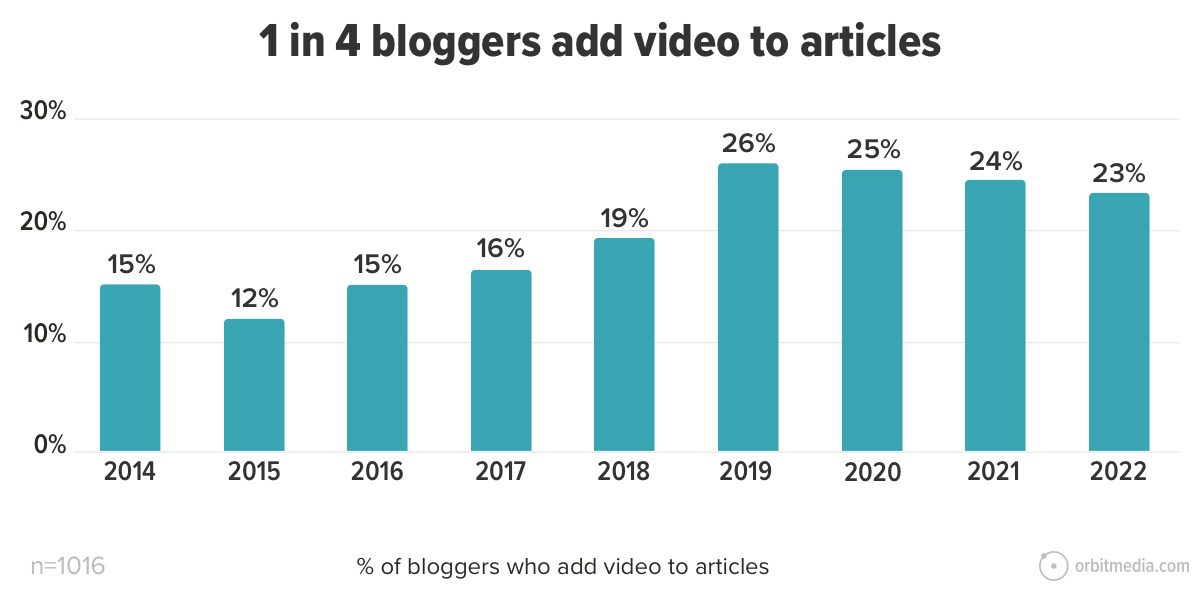
Is more visual content more effective? Yes. When we tracked the impact of videos on content engagement, we found a 4x lift to many of the engagement metrics for posts with added video.
The survey data supports this finding. The more bloggers add images and videos, the more likely they are to report success. Bloggers who use 7+ images per post are 2.3x more likely to report strong results. That’s a huge advantage.
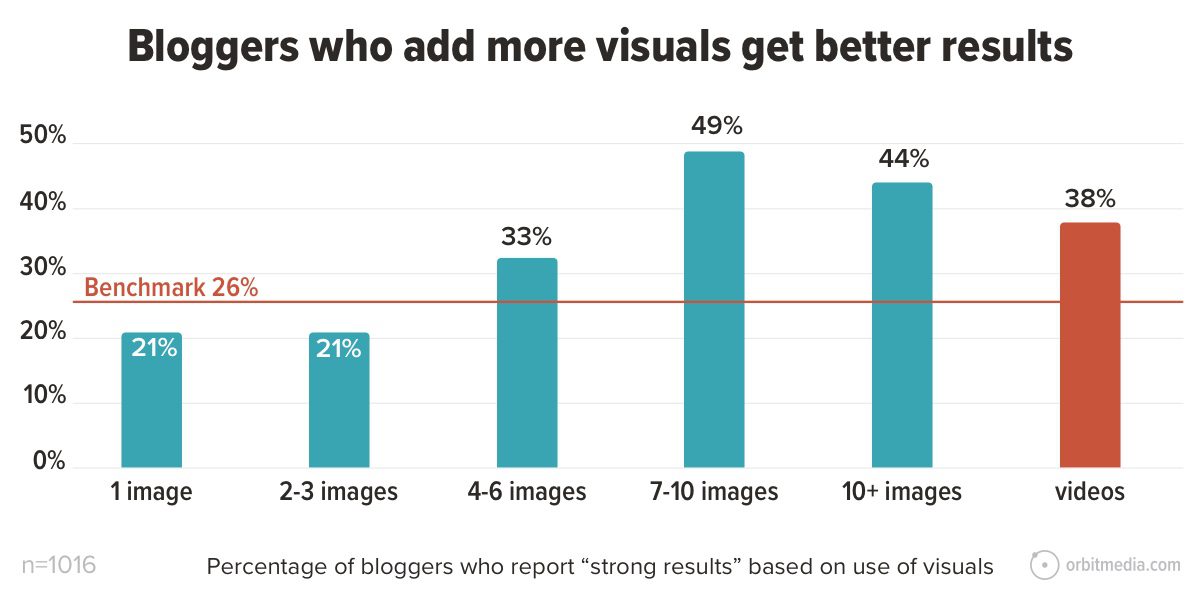
One more data point that supports this strategy: the use of infographics as a content format correlates with strong results, as we saw above. Ironically, infographics are among the least popular content formats.
 |
Tony Gnau, Founder and Chief Storytelling Officer at T60 Productions“Nobody should be surprised that bloggers who use video report success stories. Video engages our senses and taps our emotions. This becomes a powerful tool to help bloggers connect with their audience, creating an additional level of trust.” |
6. Ultra-high frequency
Another uncommon blogging strategy is to maintain high levels of output, publishing several times per week or more. The term “blog” sometimes applies to actual media websites that publish articles daily. We see these bloggers in the dataset.
Most bloggers (66%) publish weekly, monthly or somewhere in between. But a small percentage (15%) publish more than weekly. The data shows a close correlation between blogging frequency and success. The bloggers who publish 2-6 times per week are 50% more likely to report strong results.
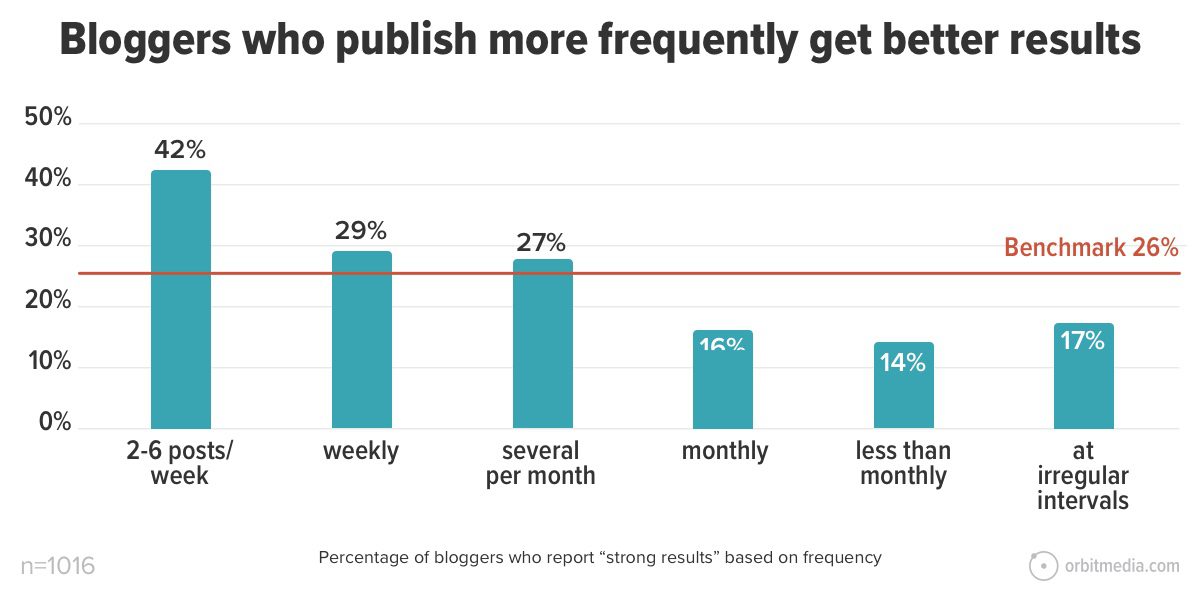
Of course, high frequency isn’t a sustainable strategy for everyone. For many corporate and small business blogs, it’s just not necessary to have a high-frequency inbound marketing program. No surprise it’s not a popular approach. The trend is toward lower-frequency publishing.
But as more bloggers focus on quality-over-quantity, it creates an opening for the counter-competitive approach of high-frequency and “flood the zone” strategies. The correlation between frequency and results is clear.
Bloggers who double down have an edge
Now that we’ve seen how various blogging strategies can make a difference, let’s consider how levels of effort impact marketing results. The following aren’t really aspects of content strategy. These correlations are more about discipline and diligence.
We’ll share these insights by simply stating what most bloggers do, then showing the increase in the chance of success for the bloggers who do much more.
Some bloggers spend more time…
Most bloggers spend 4 hours or less on each article.
The bloggers that spend 6+ hours are 50% more likely to report strong results.
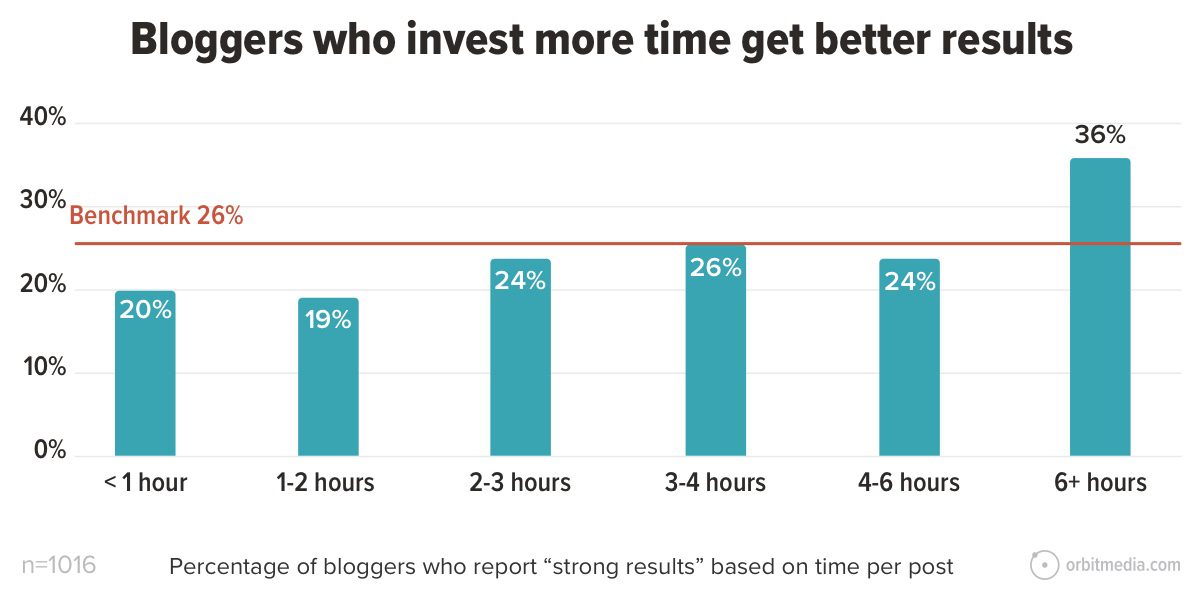
 |
Jodi Harris, Director of Content Strategy, Content Marketing Institute“Sharing thoughtfully written, engaging, and strategically focused stories is a proven way to distinguish your brand – and capture audience attention. It’s time to dispel the myth that this kind of content can be created quickly or with little effort invested.” |
 |
Paul Roetzer, Founder, Marketing AI Institute“With the rapid advancement of language AI technology, and growing adoption of AI writing tools, I’ll be very intrigued to see if the time spent per post starts trending down. AI can assist bloggers in planning, drafting and editing their content, in a fraction of the time they would have traditionally spent on a post. AI doesn’t replace human writers, but it certainly enhances what they’re capable of producing.” |
Some bloggers write longer posts…
Most bloggers write posts that are 1500 words or less.
The bloggers who write 3000+ word articles are 2.5x as likely to report strong results.
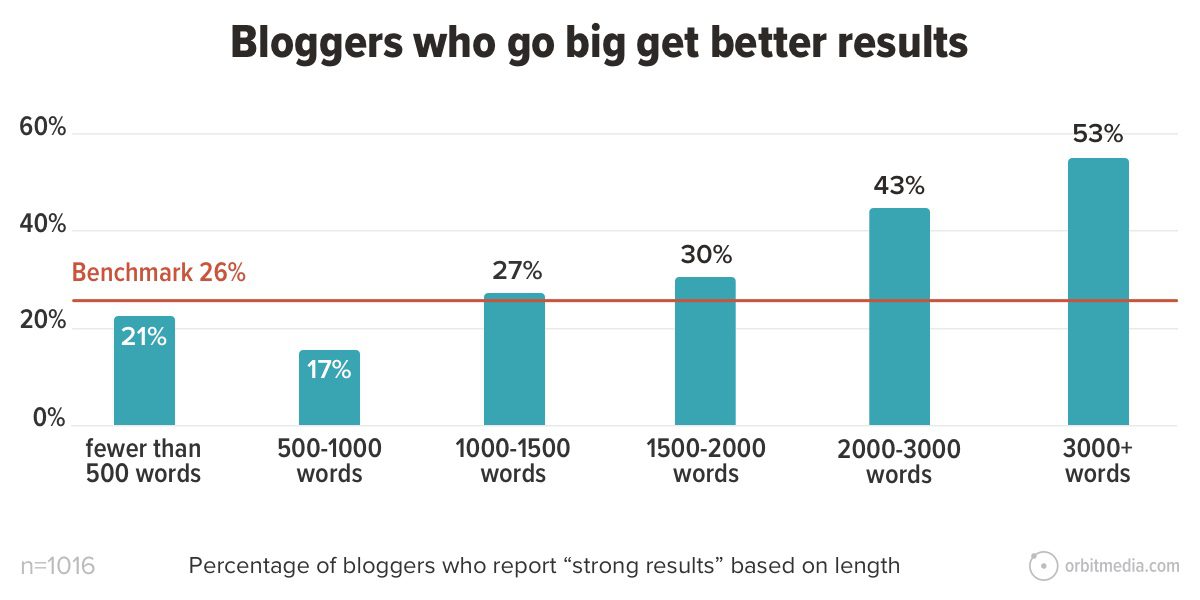
 |
Jay Acunzo, creator/host, Unthinkable“When it comes to length, bloggers need to resist the rally cry of so many under-informed marketers who claim that the world is trending short-form, so you must too. Audiences don’t have a lower tolerance for long-form. They have a lower tolerance for mediocrity. We need to decouple the question of length from the question of value. The latter needs to be apparent immediately, delivered powerfully, and combined with good storytelling techniques like open loops and moments of tension to hold people’s attention.” |
Some bloggers work with editors…
Most bloggers use an informal process for editing.
The bloggers who work with professional editors are 90% more likely to report strong results.
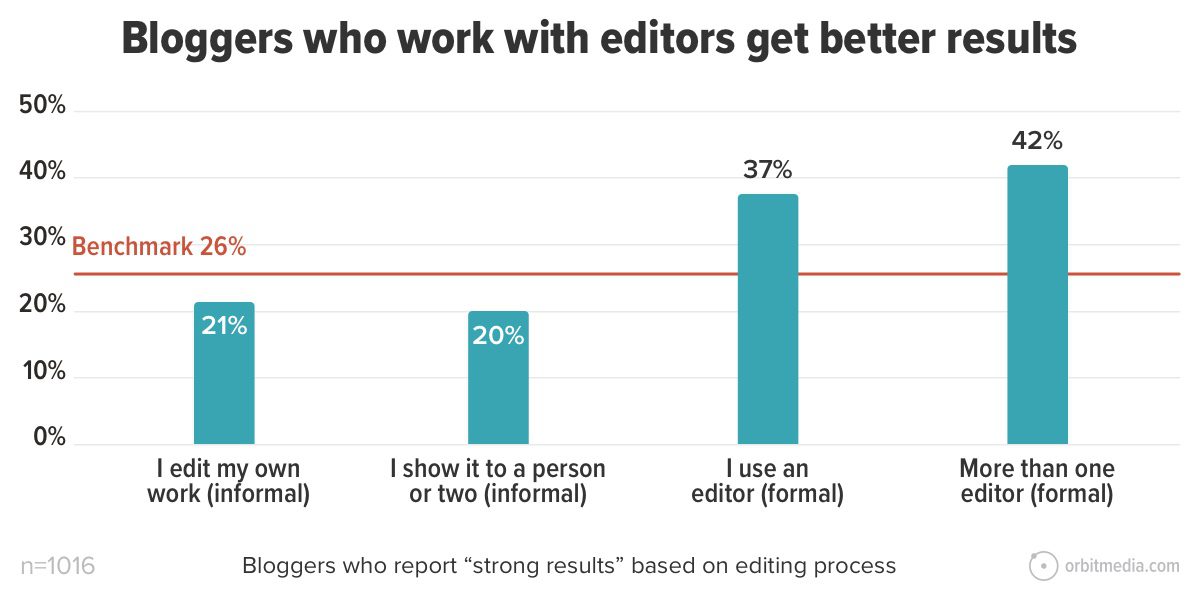
 |
Jasmine Hermann, Blogging Coach“Professional bloggers whose income results from their blogging efforts, either directly or indirectly, have greater success working with editors because they benefit from a professional outsider’s perspective and experience. Skilled editors pinpoint and fix missed grammar, punctuation, and spelling errors that others are too close to see. Unfortunately, even well-meaning friends and peers don’t have the expertise to help refine tone and sentence structure or track inconsistencies and flow like an editor. Granted, cutting unessential expenses makes sense, given the financial uncertainty of blogging in a gig economy. However, the risk of losing potential clients and readers because of poor grammar and illogical train of thought is more detrimental than the investment of working with an editor. Ultimately, just like doctors need doctors, writers and bloggers need professional editors to polish their words. Bloggers aim to publish clear and concise messaging to increase their ROE (Return on Engagement), and editors are the best choice to make that happen.” |
Some bloggers use Google Analytics to guide decisions…
Most bloggers check Analytics “occasionally” or “usually.”
Bloggers who check Analytics for every article are 78% more likely to report strong results.
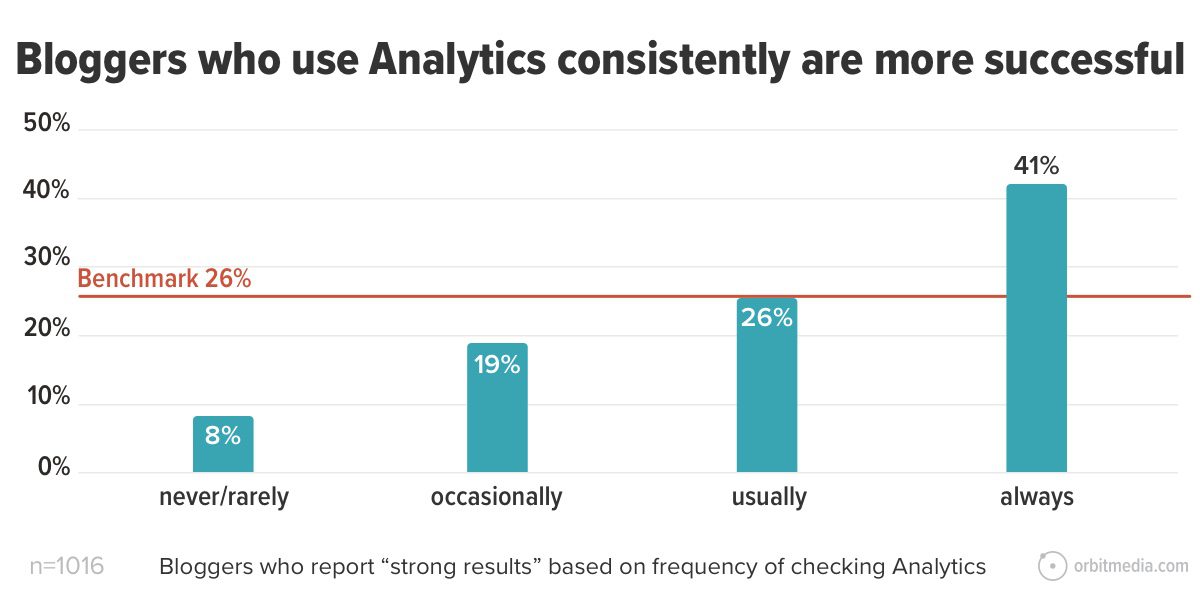
 |
Krista Seiden, Founder, KS Digital“After the July 2023 migration to GA4, I suspect that bloggers will rely on GA4 just as much as they rely on Universal Analytics. While there is a bit of a learning curve, Google Analytics remains the gold standard for site data for bloggers and marketers. It will continue to be a prominent platform for website data in the future. I also believe the product will continue to improve to a point that users will have less hesitation for the change and more excitement for the new features that GA4 brings.” |
B2B bloggers are all in but need more support
We asked the respondents if they write for B2B, B2C or both. When we compare the answers from the B2B and B2C content marketers, we find new blogging statistics that show real differences.
Bloggers who write for B2B audiences appear to be more invested in content creation. They spend more time writing each post. The B2B blogger spends 26% more time on each article than the B2C bloggers.
They also write longer articles. The typical B2B article is 1460 words compared to B2C articles, which are 1300 words. So B2B bloggers write articles that are 12% longer on average.
Here you can see the difference:
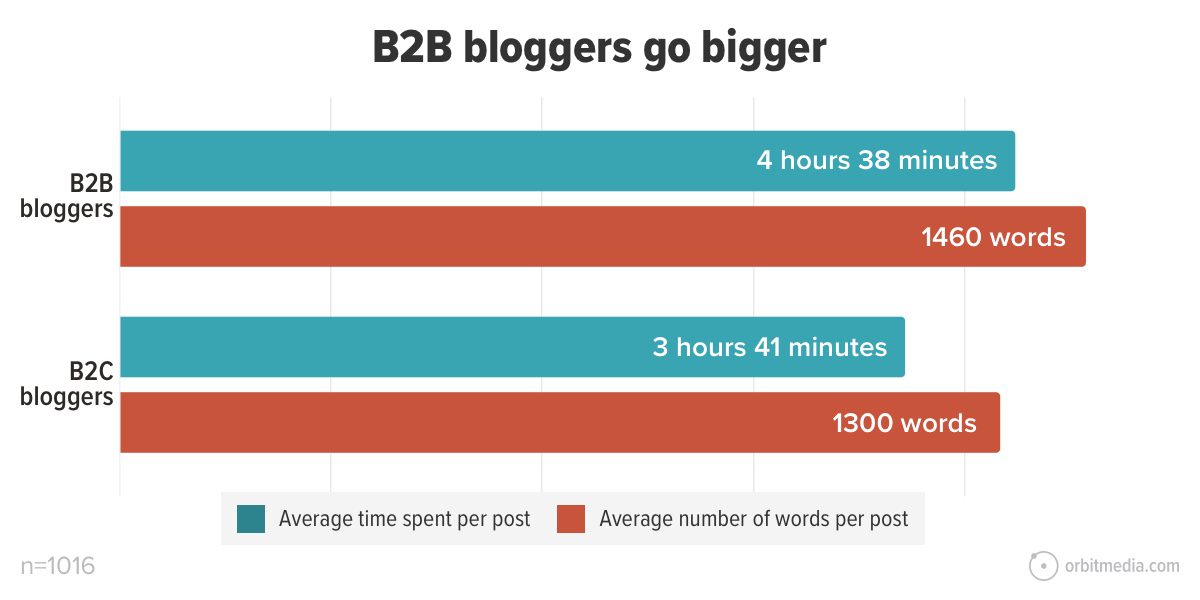
What explains these differences? We have a lot of questions. I’ll list some of them here.
Maybe it’s a function of the topics. Do B2B topics tend to require more planning and research? Or more words to explain?
Or maybe it’s a function of the competition. Are B2B bloggers going big because the competition for these high-value visitors is more intense? Is the importance of quality content greater for B2B?
Or maybe it’s something else. Are B2B content programs more mature in general? Staffed by teams who are earlier on the trends of more time and more depth?
B2B and B2C also face different challenges. When we compared the “top challenges” answers, we spotted a difference. 18% of B2B bloggers report that “getting support from within the organization” is a challenge, compared to only 8% of B2C bloggers. That’s a big difference.
B2B bloggers are 2.25x more likely to report that getting support from their organization is a challenge.
Is B2B marketing leadership less invested in content marketing? Or do the B2B topics tend to require more internal collaboration? Or does the greater effort simply mean that more resources are needed?
Thank you, bloggers!
Thank you to the 1016 bloggers who responded to this year’s survey, and to everyone who contributed to the 10,000+ total survey responses over the past nine years. You were the source for each of these business blogging statistics. You shed light on a dark corner of the world of content.
Also, thanks to our expert contributors. I recommend following, subscribing and reading each of them. We are grateful for their insights and promotion help.
And finally a huge thanks to Amanda Gant and Kyle Russell and all of my family of Orbiteers!
Methodology and Data
The respondents to this survey are self-described bloggers with whom we connected over many years on social media and at live events.
- No one was incentivized to take the survey in any way
- The dataset is heavily populated with my personal network, which skews toward LinkedIn users, B2B marketers and people in the US active in business blogging
- Responses were gathered in August and September of 2022
- This is a survey of bloggers (individuals), not companies or brands (groups)
- “Strong results” is deliberately left vague since the respondents and their goals are diverse.
Data was captured using a simple one-page survey of 20 questions. Early versions of the blogging statistics and trends were sent to our expert influencers to gather insights.
How is this survey promoted? Read our original research playbook here.
[ad_2]
Source link









